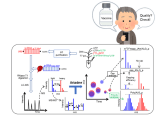Cannabis: the challenges and controversies

Kevork Kalaydjian is the Director of Sales for Zef Scientific Inc. (ZefSci; QC, Canada). He has been contributing to the scientific space through service and equipment innovation since 2005. ZefSci are the official distributor of Shimadzu (Kyoto, Japan) scientific equipment in Canada. Through the combination of service delivery and state-of-the-art Shimadzu equipment, ZefSci is able to provide unique and tailored solutions. ZefSci has also been a leading multi-vendor service provider for the analytical space since inception. Their services extend from repair, maintenance and compliance on most major brands and models such as SCIEX (MA, USA), Waters Corporation (MA, USA) and Thermo Fisher Scientific (MA, USA) (all brands are trademarks or registered trademarks of their respective holders, use of them does not imply any affiliation with or endorsement by them).
Q Over recent years, interest in medical cannabis has increased due to developments in some countries which are now regulating the substance. How is ZefSci involved in the cannabis industry?
Cannabis is a unique plant with a very complex matrix, due to its complexity it has a variety of ‘applications’. Canada is one of the first countries to federally legalize cannabis and it only made sense that a scientific approach would be necessary to better grasp these ‘applications’. ZefSci and Shimadzu are leaders in the area of analytical and chromatography sciences; we’re able to provide Canadian laboratories scientific solutions for growers, extractors, research centers and analytical testing laboratories. Our solutions are focused on the scientific techniques with state-of-the-art analytical equipment so that we can better understand the plant and its limitless scientific applications. ZefSci are bringing the knowledge acquired from the last 2 decades working in the pharmaceutical industry to elevate the science and compliance of acquiring robust and accurate results related to any cannabis product.
Q The use of medical cannabis remains a controversial topic with different countries and jurisdictions upholding various laws and regulations. Why do you think the bioanalytical industry should get involved with cannabis analysis?
As more countries slowly legalize the use of medical and recreational cannabis, additional research will be conducted in an attempt to identify various strains and their ‘applications’. In such a context, it will only be natural that pharmaceutical and biotech companies will start adopting these attributes to their products. One immediate example would be the surge of opioid abuse – companies have already started investigating possible replacements, such as a therapeutic combination of both opioid and cannabis to help prevent or at least reduce the use of opioids. Such advancements cannot be ignored and only the bioanalytical industry can truly help propel the understanding of the scientific benefits of cannabis.
Q What are the rules and regulations for medical cannabis in Canada?
Outside of the possible medical applications of cannabis – Canada has also legalized cannabis for recreational use. Consequently, Health Canada (ON) has set stringent rules regarding the sale of cannabis, covering everything from shipping to packing and testing. However, the regulations that the scientific community are interested in include:
|
|
|
|
|
|
|
|
|
Pesticide is the key element to guarantee a product ‘lot’ release with an accepted certificate of analysis by a certified third party analytical lab. At this time approximately 96 pesticides are on the list with LOQ’s as low as 0.01ppm and this list will grow as more and more compounds are added by Health Canada. Pesticide is the most important element of any certificate of analysis but also the most labor intensive. This is another key area where ZefSci and Shimadzu can contribute to achieving current regulations and be ready for any future pesticides put on the list.
Q What technologies do you use for cannabis testing?
| Description | Assays available |
| Liquid chromatograph (HPLC–UV) |
|
| Mass spectrometer for liquid based injections |
|
| Gas chromatograph with mass spectrometer head space and liquid injection port |
|
| Gas chromatograph with headspace and liquid injection port with FID detector |
|
| Moisture balance |
|
| Inductively coupled mass spectrometer | Heavy metals
|
| PCR/quantitative PCR |
|
| Stability chambers |
|
Q What instrument research platforms do Shimadzu offer for cannabis analysis?
Shimadzu Corporation was founded in 1875 and has been one of the leading manufacturers of analytical equipment ever since. They offer a complete solution in most of the scientific space but in most recent years have been able to gain the market share for cannabis and hemp testing. The state-of-the-art LC–MS 8060 tandem triple quad with ultra-fast scanning and switching has played an instrumental role in this success for quantifying low amounts of cannabinoids. But LC–MS/MS machines can only see what we tell them to look for (using a MRM base technique), without any accurate system like a time-of-flight (for example, LC–MS 9030), it would be very time consuming to identify and confirm with 100% confidence what their molecular structure is; very similar to the fingerprint of a molecule. At this time LC–MS/MS can accurately quantify all the abundant and semi abundant cannabinoids but the LC–MS 9030 is needed to locate and analyze all the new molecules related to the larger family of cannabinoids.
Q It is important that cannabis products are tested and accurately labelled. What challenges have you encountered when analyzing potency?
The most challenging elements come from: flowers, oil, kief, hashish or any concentrate including edible product(s). Flowers are currently the most common medium to be tested but with the law adopting edibles, we believe the dominant sample for all QCs and third party labs will be edibles. All other mediums (kief, oil, hashish and edible) have higher concentrations of cannabinoids and terpenes, this will affect what type of instrument is needed for the analysis. For flower analysis, LC–UV is typically what the industry is using. For the higher concentrate products, LC–MS/MS will become more popular because you have multiple orders of concentration between low abundance compounds (ppt) and very high abundance compounds like THC (ppm) within the same sample! Products like the isolate used in edible are very pure. LC–MS/MS will allow bioanalysts to separate very low abundance compounds from something that could represent 90% of the relative cannabinoid ratio in the end product. LC–UV could be limited by the time required to separate every compound and then calculate the relative ratios. Using LC–MS/MS we would be able to just look at the C13 of the molecules with limited separation so the run time is still acceptable (10–15 minutes) versus LC–UV, which would need a longer run time since the most abundant peak would drag for minute(s) and hide other compounds that are eluted at a similar time.
Current techniques and hardware are ready to quantify any product but validated methods like those used in the Pharma industry or CRO’s are a key factor to create and achieve good laboratory practice; without strong compliance and good laboratory practice method(s) any data would almost be irrelevant. Currently, the grower is responsible for labeling and creating their own lot number and sampling that lot for analysis. The questions always remain what are they sending to be tested? Where was this sample taken from?
Q The health benefits of cannabis have been demonstrated with research in this field increasing. What developments do you hope to see in the future?
Now more than ever we need companies and individuals to be more open minded with the concept that medical and recreational cannabis can be beneficial to our health. At the same time excess use can also be damaging. I am sure we have all heard that a single glass of wine per day can help with the heart, but alcohol consumption regularly can damage the liver. Cannabis is no different, what we require now are dedicated teams and researchers to understand the limits and the advantages of this unique plant so that we can advance medicine with combined therapeutics and pharmaceutical discovery.





